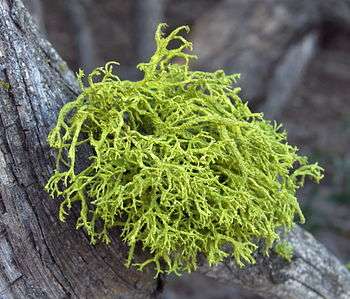Fruticose lichen
A fruticose lichen is a form of lichen fungi that is characterized by a coral-like shrubby or bushy growth structure. It is composed of a thallus and a holdfast. It is formed from a symbiotic relationship of a photobiont such as cyanobacteria and two mycobionts.[1] Fruticose lichen is composed of a complex vegetation structure, and characterized by an ascending, bushy or pendulous appearance. While lichen communities are mainly controlled by water and light, vegetative dispersal and filamentous growth in fruticose lichen is often associated with areas of low elevation. Fruticose lichens can endure high degrees of desiccation. They grow very slowly and will often occur in extreme habitats such as on tree barks, on rock surfaces and on soils in the Arctic and mountain regions.

Characteristics
Fruticose lichen is a form of lichen composed of a shrubby or bushy thallus and a holdfast. The thallus is the vegetative body of a lichen that does not have true leaves, stems, or roots. Thallus colour of the lichen can be attributed to the amount of light in its environment. A light thallus color is associated with lower light conditions within the growing environment. Fruticose lichen is characterized by photobionts, the mode of vegetation dispersal, growth form and the substrate preference. The lichen's ability to survive extreme desiccation is due to its ability to quench excess light energy.[2][3][4] Characteristic of fruticose lichen is the shape of the thallus. Like crustose lichen, fruticose lichen is composed of a holdfast which will act as an anchor for the lichen to grow in rock fissures, over loose sand or soil.[5]
Growth and structure
_(8558189274).jpg)
Fruticose or ‘shrubby’ lichen differ from other forms of lichen based on their bushy form that is attached to the ground only at the base of the lichen. The most important difference that distinguishes fruticose lichen from other forms of lichen is the continuous algal layer that grows around the circumference of the branches of the lichen.[6] The thallus may be either rounded or flattened, unbranched or branched.[7] Fruticose lichens have a fine, round, hair-like structures and are loosely attached to rocks and trees.[6] Although fruticose lichens are defined as being bushy, they can also exhibit a flattened and strap-like appearance.[6] Highly branched fruticose lichen have a high surface to volume ratio that results in a rapid drying and wetting pattern compared to lichens that have a lower surface to volume ratio.[5]
The internal structure of fruticose lichen is composed of a dense outer cortex, a thin algal layer, a medulla and a hollow center or a dense central cord.[7] The structure of fruticose lichens depends also on their mycobionts.[8] Lichen undergoes diffuse growth and the thallus elongates over time.[9] New branch cells grow through the wall materials of older neighboring cells.[9][10] Microenvironmental conditions influence individual thalli and branches causing non-uniform growth.[9] There are 11 stages of growth for fruticose lichen from the beginning to end of their life cycle.[11]
Reproduction and dispersal
Lichens reproduce by means of spores or vegetatively. This characteristic is also seen in free-living fungi and many other plants.[6] There are three common spore-bearing structures found in lichens: the apothecium, the perithecium and the pycnidium. The apothecium is described as being either sessile or immersed. The thallus is known as sessile if it sits atop the surface of its growth medium. If the apothecium is level with or sits below the surface it is known as immersed. The second form of spore-bearing structure is a perithecium which refers to the complete immersion in the substratum of rock or bark. Finally, the pycnidium, commonly seen on the surface of foliose lichen and crustose lichen, are absent in fruticose lichens.
Diversity
_(14744008916).jpg)
There are many different varieties of fruticose lichen. Each type of fruticose lichen will differ in structure and some types will be more dominant in a particular environment compared to other forms of fruticose lichen.
- Pseudephebe minuscula has a fruticose thallus consisting of thin branches that result in the formation of dense mats.[12]
- Pseudephebe pubescens has thin branches that are loosely entangled.[12]
- Usnea has stringy strands that may be short, tufted and bush-like, and may reach a length of several meters. This form of lichen has a characteristic tough central core. This gives a mild degree of support to the lichen while also providing storage for a large proportion of the water contained in this form called fruticose lichen.
Distribution and accumulation
Fruticose growth forms can be found in wet humid climates, in temperate rainforests, or in arid conditions.[5] Fruticose lichens are most commonly distributed in mountains, forests and arctic tundra. The accumulation rate of lichen varies within different environments. Lichen accumulation rate decreases from mountain to alpine belts and from tree top to base.[13] This is because lichen near tree tops are in their early life stages when growth rates are higher. Lower lichen accumulation of the alpine belt may be explained by harsh climate.
Economic and ecological significance
Although they lack economic importance comparable to that of their algal and fungal components, lichen play an important role in nitrogen cycling, providing critical winter forage for caribou and colonizing newly exposed surfaces.[14]

References
- Spribille, Toby (21 July 2016). "Basidiomycete yeasts in the cortex of ascomycete macrolichens". Science. 353 (6298): 488–92. doi:10.1126/science.aaf8287. PMC 5793994. PMID 27445309.
- Komura, Masayuki; Yamagishi, Atsushi; Shibata, Yutaka; Iwasaki, Ikuko; Itoh, Shigeru (2010-03-01). "Mechanism of strong quenching of photosystem II chlorophyll fluorescence under drought stress in a lichen, Physciella melanchla, studied by subpicosecond fluorescence spectroscopy". Biochimica et Biophysica Acta (BBA) - Bioenergetics. 1797 (3): 331–338. doi:10.1016/j.bbabio.2009.11.007. PMID 19962955.
- Veerman, John; Vasil'ev, Sergej; Paton, Gavin D.; Ramanauskas, Justin; Bruce, Doug (2007-11-01). "Photoprotection in the Lichen Parmelia sulcata: The Origins of Desiccation-Induced Fluorescence Quenching". Plant Physiology. 145 (3): 997–1005. doi:10.1104/pp.107.106872. JSTOR 40065739. PMC 2048789. PMID 17827268.
- Singh, Ruchi; Ranjan, Sanjay; Nayaka, Sanjeeva; Pathre, Uday V.; Shirke, Pramod A. (2013-01-05). "Functional characteristics of a fruticose type of lichen, Stereocaulon foliolosum Nyl. in response to light and water stress". Acta Physiologiae Plantarum. 35 (5): 1605–1615. doi:10.1007/s11738-012-1203-8. ISSN 0137-5881.
- Nash, Thomas, ed. (2010). Lichen Biology (Second ed.). Cambridge, New York: Cambridge University Press. ISBN 9780521871624.
- Baron, George (1999). Understanding Lichens. Slough, England: Richmond Publishing Co. Ltd. ISBN 978-0855462529.
- Hale, Mason (1967). The biology of lichens. London, England: Edward Arnold. ISBN 978-0713124569.
- Hawksworth, D.L.; Hill, David J. (1984). The lichen-forming fungi. Tertiary Level Biology. Glasgow : New York: Blackie: Chapman & Hall. ISBN 978-0412006418.
- Sanders, William B.; Tokamov, Sherzod A. (2015-01-01). "Diffuse growth in the fruticose beard lichen Ramalina usnea (L.) R. Howe". The Lichenologist. 47 (1): 51–58. doi:10.1017/S0024282914000504. ISSN 1096-1135.
- Sanders, William B.; Ríos, Asunción de los (2012-06-01). "Development of thallus axes in Usnea longissima (Parmeliaceae, Ascomycota), a fruticose lichen showing diffuse growth". American Journal of Botany. 99 (6): 998–1009. doi:10.3732/ajb.1100287. ISSN 0002-9122. PMID 22623609.
- Suetina, Yu G.; Glotov, N. V. (2010-02-09). "Ontogeny and morphogenesis of the fruticose lichen Usnea florida (L.) Weber ex F.H. Wigg". Russian Journal of Developmental Biology. 41 (1): 24–31. doi:10.1134/S1062360410010030. ISSN 1062-3604.
- Huiskes, A.h.l.; Gremmen, N.j.m.; Francke, J.w. (1997-03-01). "Morphological effects on the water balance of Antarctic foliose and fruticose lichens". Antarctic Science. 9 (1): 36–42. doi:10.1017/S0954102097000059. hdl:20.500.11755/ebe4e2c2-a5bf-47dc-93b8-c3edbc603297. ISSN 1365-2079.
- Arseneau, Marie-Josée; Ouellet, Jean-Pierre; Sirois, Luc (1998-10-01). "Fruticose arboreal lichen biomass accumulation in an old-growth balsam fir forest". Canadian Journal of Botany. 76 (10): 1669–1676. doi:10.1139/b98-144. ISSN 0008-4026.
- Nelson, Peter R.; McCune, Bruce; Swanson, David K. (2015-08-17). "Lichen traits and species as indicators of vegetation and environment". The Bryologist. 118 (3): 252–263. doi:10.1639/0007-2745-118.3.252.